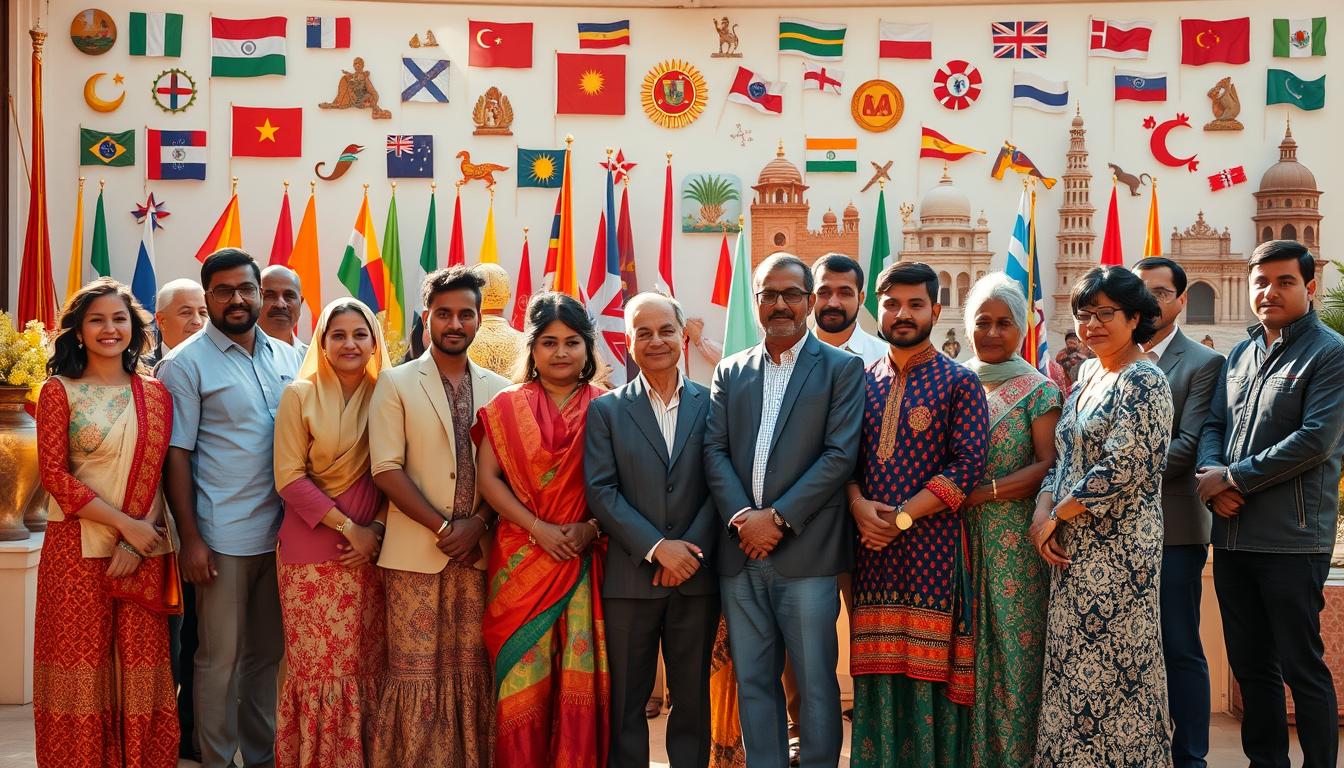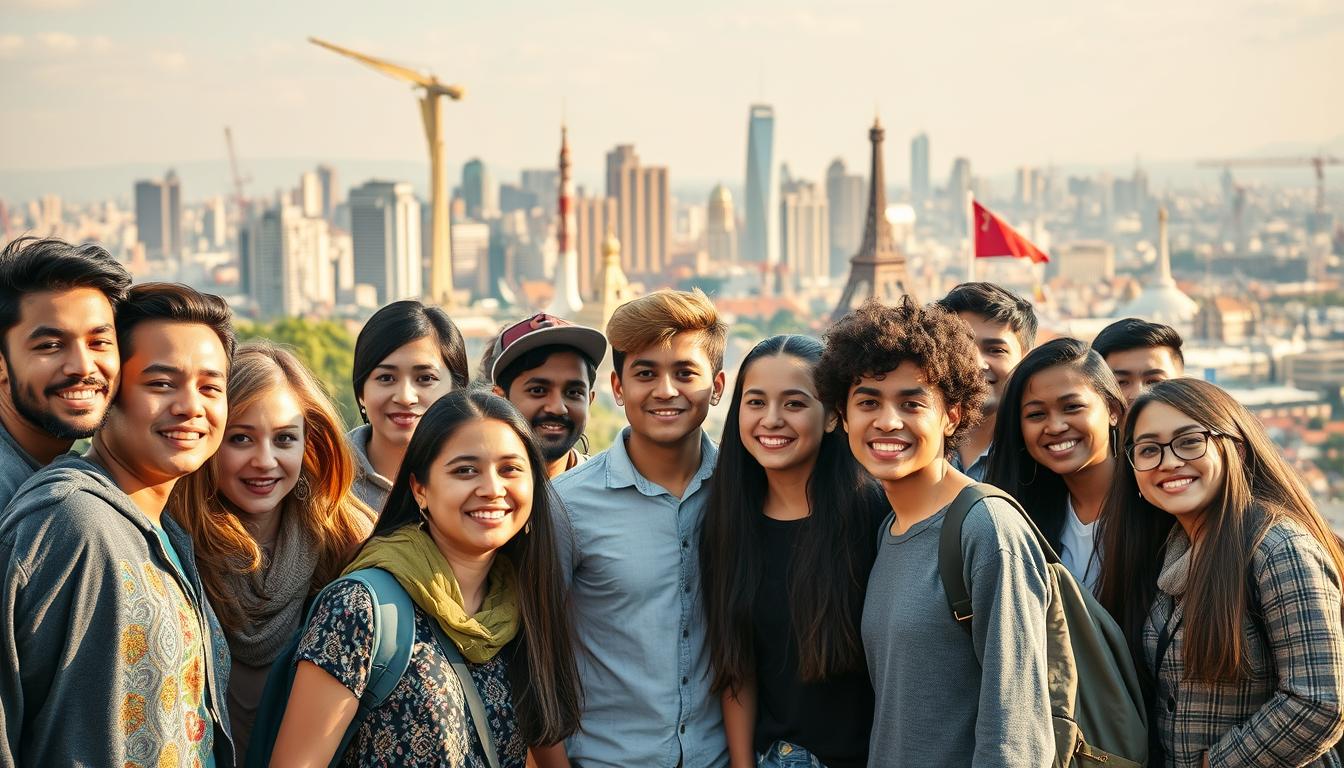Building a Sustainable Future: Cultural Exchange and Environmental Awareness Programs
In today’s world, facing big global challenges, sustainable development is key. It combines cultural exchange and environmental awareness for a better future. Communities around the globe are tackling climate change and using up resources fast.
It’s crucial to connect and share eco-friendly practices. These efforts show how different issues are linked and encourage new ways to be sustainable. By working together, we can make our planet healthier.
Understanding Sustainable Development
Sustainable development is about finding a balance. It meets today’s needs without harming tomorrow’s. It’s about protecting the environment, being economically sound, and ensuring fairness for all.
This idea pushes for action on climate change. It also calls for everyone to take responsibility for their actions.
Definition and Key Principles
The heart of sustainable development is living in a way that’s good for the planet. It’s about:
- Keeping natural resources for the future
- Ensuring everyone has access to resources and jobs
- Using resources wisely and responsibly
Following these principles helps us tackle big environmental problems. It leads to a better future for all.
Importance in Today’s World
It’s vital to understand sustainable development today. The world faces huge environmental challenges like climate change and pollution. We all need to work together to solve these issues.
By taking action, we not only protect the environment. We also create jobs in green industries. This shows that being sustainable is good for everyone.
The Role of Cultural Exchange in Sustainability
Cultural exchange is a key way to promote sustainable practices and bring people together. It lets people share their stories and traditions. This helps raise awareness about the need to protect our planet.
Enhancing Global Awareness
Cultural programs teach us about environmental issues worldwide. They show how different places tackle these problems. This knowledge encourages us to think differently about our planet.
By learning from others, we see the success of green initiatives. This can motivate us to adopt eco-friendly ways of living. It’s a step towards a greener future for all.
Building Bridges Among Diverse Communities
Cultural exchange helps connect different communities. It makes us understand and appreciate each other’s views. This understanding leads to better cooperation on sustainability projects.
Working together, we can find new ways to solve environmental problems. This teamwork is essential for protecting our planet and achieving sustainable development.
Educational Programs for Sustainability
Adding sustainability to school lessons makes learning more meaningful. It helps students become environmentally aware. Programs that teach eco-friendly habits make students feel responsible.
By mixing sustainability into different subjects, students learn about their part in a green future.
Curriculum Integration
Teaching sustainability in various subjects gives a full view of environmental problems. Teachers use many ways to do this, like:
- Project-based learning that tackles real environmental issues.
- Teamwork in eco-friendly projects.
- Field trips to see sustainability in action.
These methods not only deepen knowledge but also make students think about their environmental impact.
Empowering Future Generations
Teaching youth about sustainability builds a lifelong dedication to it. Getting students involved in community projects and clubs boosts their leadership. These activities help students:
- Start initiatives for sustainable living in their communities.
- Work together to solve environmental problems.
- Learn from local groups and get more involved in green education.
So, educational programs are key in raising a generation ready to protect our planet.
Environmental Awareness Initiatives
Environmental awareness initiatives aim to get communities involved in sustainable practices. It’s important to engage local residents to make them feel responsible for protecting the environment. These efforts encourage people to adopt eco-friendly habits, building a sustainable culture.
Community Engagement Strategies
Good community engagement strategies can boost environmental awareness and inspire action. Programs use several methods to promote green living:
- Workshops and training sessions: Educational events give people the tools to protect the environment.
- Volunteer events: Activities like clean-ups and tree planting get people directly involved in sustainability.
- Incentive programs: Rewards for green actions, like recycling, keep people engaged over time.
Leveraging Technology for Awareness
Green technology is key in spreading environmental awareness. Digital tools help reach more people through campaigns. Social media can spark a movement, letting communities share and learn from each other worldwide. Apps also help by providing updates on local issues and tracking community efforts.
Case Studies of Successful Programs
Looking at case studies shows us how some programs have made a big difference. They’ve used sustainable practices to help their communities. These stories show how new ideas can lead to big changes for the environment.
Program A: Impact on Local Communities
In Portland, Oregon, the “Green Infrastructure Initiative” has made a big splash. It brings nature into the city by adding rain gardens and green roofs. This not only helps with stormwater but also makes more green spaces for people.
People living there now feel more connected to their environment. They’re more likely to join in on local green projects. This shows a big shift towards caring for the planet.
Program B: Innovative Approaches
In San Francisco, the “Eco-Champions Program” is leading the way in sustainability. It teaches people to be leaders in their communities. They learn about reducing waste, saving energy, and gardening in a green way.
This program doesn’t just teach; it brings people together. It’s helped cut down on waste and made the city greener. It shows that other places can do the same.
Collaboration with NGOs
Non-governmental organizations (NGOs) are key in pushing for sustainable development. They bring expertise and reach out to communities, making a big difference. Working together with local groups and governments, NGOs can create lasting change.
Strengthening Partnerships
Building strong partnerships is crucial for sustainable development. NGOs, local governments, and community groups work together, sharing goals and ideas. This teamwork leads to better projects and solutions for the environment.
Sharing Resources and Best Practices
NGOs can share resources and learn from each other through collaboration. This exchange helps improve sustainability programs. By working together, they can tackle environmental issues more effectively and efficiently.
Government Policies Supporting Sustainability
Government policies are key in pushing for sustainability in many areas. Laws aimed at protecting the environment help set up rules for green practices. They also push businesses and communities to innovate and follow these rules. This effort is crucial for keeping our planet safe for the future.
Legislation for Environmental Protection
Many laws and rules help protect the environment. They work to cut down pollution, save resources, and encourage sustainable land use. These laws give clear rules for companies to follow green practices.
Following these rules helps companies be more responsible and have a positive effect on communities. For example, the Clean Air Act and the Clean Water Act set standards for a healthy environment.
Funding for Sustainable Projects
Government funding is essential for green projects. It includes grants, tax breaks, and low-interest loans for local groups and non-profits. This support lets them start projects they might not have been able to afford otherwise.
Projects like renewable energy, reducing waste, and community gardens get this help. It encourages greener practices and makes communities stronger.
The Importance of Renewable Resources
Renewable resources are key to a sustainable future. They help us make energy without harming the environment. This section talks about the different types of renewable energy and their economic benefits.
Types of Renewable Energy
There are many kinds of renewable energy, each with its own role. Here are a few:
- Solar energy: This uses sunlight to make electricity, thanks to solar panels.
- Wind energy: Wind turbines turn wind into electricity, using its kinetic energy.
- Hydroelectric power: It uses water flow to create electricity, showing nature’s power in energy.
- Geothermal energy: This taps into Earth’s heat, providing a steady energy source.
- Biomass: It turns organic materials into energy, making waste useful.
Economic Benefits of Transitioning
Switching to renewable energy brings big economic wins. These benefits include:
- Job creation: The renewable energy field is booming, creating new jobs in many areas.
- Lower energy costs: Investing in renewables can cut down energy bills for homes and businesses.
- Reduced dependence on fossil fuels: Moving to renewables makes us less reliant on global fuel markets.
The Role of Businesses in Sustainable Development
Businesses play a key role in sustainable development. They do this through corporate social responsibility (CSR). CSR helps them tackle social issues while making money. It shows they care about the planet and people, boosting their reputation.
Corporate Social Responsibility Initiatives
Businesses can help their communities and the environment through CSR. They adopt sustainable practices in their work. This includes:
- Using less energy in their buildings and operations.
- Supporting local projects to improve social well-being.
- Encouraging employees to help the environment through volunteering.
These green initiatives show they care about more than just profits. They align with the bigger goal of sustainable development.
Sustainable Supply Chain Practices
Businesses are changing how they source and move goods. They see that a sustainable supply chain is better for everyone. Key steps include:
- Working with suppliers who care about the environment.
- Lessening waste by recycling and reusing materials.
- Using new technologies to use resources better.
These actions make businesses more efficient and help the planet. By doing this, they help create a better economy. They show they are serious about corporate social responsibility and working towards a greener future.
Engaging Youth in Sustainability Efforts
Youth engagement is key to moving sustainable development forward. By getting young people involved in environmental projects, we teach them about responsibility and awareness. This not only empowers them but also brings fresh ideas to the table for a greener future.
Youth-Led Initiatives
Across the globe, youth-led initiatives are making a big difference. These projects range from urban gardens to clean-up efforts. They improve local ecosystems and motivate others to take action.
- Community recycling programs
- Climate action groups focused on advocacy
- Educational workshops on sustainable practices
Importance of Mentorship
Mentorship in sustainability is vital for young activists. Mentors offer guidance, support, and direction. They help youth overcome obstacles in their projects. Strong mentorship networks share skills and knowledge, making youth efforts more effective.
“Empowering youth with the right mentorship can catalyze remarkable change in sustainability practices.”
Building these mentorship relationships boosts community success in sustainable goals. It encourages more youth to get involved.
Challenges in Achieving Sustainable Development
Reaching sustainable development is tough and needs a wide range of solutions. Economic gaps and cultural differences are big obstacles. They are key to making sustainability efforts work.
Addressing Economic Disparities
Economic gaps can block the way to sustainable development. They limit access to resources, education, and chances. People and groups in tough economic spots can’t join or gain from green projects. We need policies that make things fair and include everyone.
- Start funding programs for poor communities.
- Make jobs in green tech and sustainability available.
- Give local businesses a push to go green with rewards.
Navigating Cultural Differences
Different cultures can make it hard to start sustainability projects. Each group has its own values, beliefs, and ways of doing things. It’s important to understand and respect these differences to work together well.
- Have open talks to share ideas and views among different groups.
- Make programs that fit with local cultures.
- Train people involved in green projects to understand different cultures.
The Future of Sustainable Development
The world is facing big environmental challenges. New innovations are lighting the way for a sustainable future. These include green technology and sustainable materials.
Renewable energy, better energy use, and circular economies are key. They help make our society more sustainable. These efforts are crucial for a greener tomorrow.
Innovations on the Horizon
New tech like artificial intelligence and blockchain are changing the game. They make supply chains more transparent and support green efforts. Startups are using bioengineering to make plant-based products, reducing our need for fossil fuels.
These breakthroughs show how future tech can help us use resources better. They promise a healthier planet for all.
Building a Collaborative Global Framework
Working together is vital for solving big sustainability problems. Nations must collaborate to tackle these issues. Sharing knowledge and resources is essential.
International partnerships are key to achieving sustainability goals. A united effort will lead to a better future for everyone. Together, we can create a fair and sustainable world.
FAQ
What is sustainable development?
How can cultural exchange contribute to sustainability?
What types of educational programs promote sustainability?
How do technology and social media impact environmental awareness?
Can you provide examples of successful programs that promote sustainability?
What role do NGOs play in sustainable development?
How do government policies support sustainable practices?
What are the economic benefits of renewable energy?
How can businesses contribute to sustainability?
Why is youth engagement important in sustainability efforts?
What challenges hinder sustainable development?
What innovations are shaping the future of sustainable development?
Published on: 28 de March de 2025

Luke Martin
Luke Martin, author of Credwallets.com, is a mathematics graduate with a specialization in financial markets. Known for his love of pets and his passion for sharing knowledge, Luke created the site to provide valuable insights into the complexities of the financial world. His approachable style and dedication to helping others make informed financial decisions make his work accessible to all, whether they're new to finance or seasoned investors.







